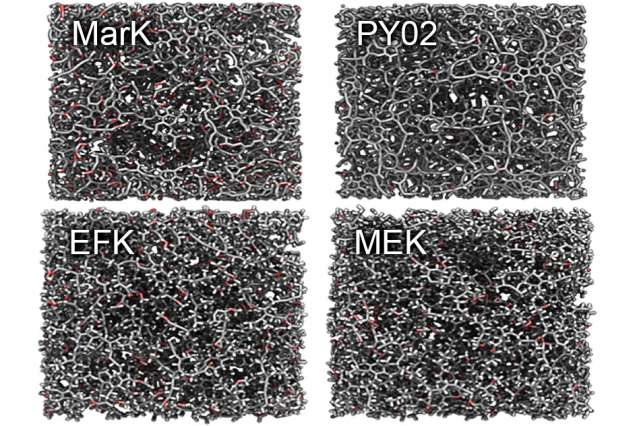Feb 2 2016
Kerogen is a dark-colored hydrocarbon solid that develops the fuels used for many daily activities. The main source of diesel fuels and gasoline is petroleum, and natural gas is utilized mainly for producing electricity, and also for heating and cooking. Despite this, the basic internal structure of kerogen is poorly understood.
A joint team, including MIT researchers and the French government research organization CNRS, have presented an in-depth study outlining the internal structure of kerogen down to the atomic level. The results from this study have been published in Nature Materials in a paper by MIT postdoc Colin Bousige, visiting scientist Benoit Coasne, senior research scientist Roland J.-M. Pellenq, professor Franz-Josef Ulm, and colleagues at MIT, CNRS, and other institutions.
 Images produced by the researchers show the molecular structure of different samples of kerogen and reveal the significant structural differences between "mature" kerogens, at top, and "immature" kerogens, at bottom. (Credit: Courtesy of the researchers)
Images produced by the researchers show the molecular structure of different samples of kerogen and reveal the significant structural differences between "mature" kerogens, at top, and "immature" kerogens, at bottom. (Credit: Courtesy of the researchers)
The results highlight vital information about the movement of oil and gas through pores in deep underground formations, allowing an estimate to be made of the amount of recoverable reserves more accurately, and also by highlighting other possible methods of extracting them.
A “game-changing” revelation
Kerogen is a combination of organic materials, mainly the remains of dead and decomposed animals, plants, and microbes that have been buried underground and compressed. This entire method leads to the formation of a rock-hard, carbon-rich material containing pores of different sizes. The hydrocarbon molecules present in the kerogen get divided into petroleum or gas when the molecules are transformed, due to geothermal heat or pressure. The petroleum or gas then passes through the pores and is released through a drilling process.
The Darcy equation, a conventional formula used by the gas and petroleum industries to explain the underground movement of these fluids, is considered to be inaccurate when hydrocarbon fluids are present inside kerogen. Current understanding could alter the interpretation of the behavior of oil and gas reservoirs, mostly found in shale formations.
[As the fluids pass through the pores in the deep rock] the flux in these nanopores, what we call the transport properties, are not what is given by the macroscale physics of liquids.
Roland J.-M Pellenq, Senior Research Scientist, Department of Civil and Environmental Engineering, MIT
The traditionally used formula suggests that gas or oil will flow, but in reality this flow stops based on the predictions in the new model. The study explains that the sizes of the pores in the rock are often smaller and also less interlinked than expected. The individual molecules of gas or oil are prevented from behaving like fluids in a collective manner, and finally get stuck in place.
This interpretation of the nanoscale structure of pore spaces found in kerogen is “a true new idea, it’s a game changer,” says Pellenq. It was previously understood that the pore spaces in deep underground formations were a lot larger, allowing easy flow of the gas or petroleum through the pores. “Those nanopores were not expected by the industry,” he says.
What that reveals, he explains, is that “those molecules trapped in those pores are really trapped.” Even though researchers assumed that increased pressure or improved solvents could help release molecules from the rock, “these nanopores are really a big part of the porosity of kerogen,” he says, and play a significant role in comprehending the recoverability of reserves.
The hydrofracking process
Today, industries extract fluids from the big pores formed in the fracture, Pellenq says. However this fracking process “is not even touching the real treasure, which is in the walls, in the pores of the wall.”
The study suggests that the most suitable approach is to replace the standard water-based hydrofracking solutions.
“Those formations, and especially those pores, are hydrophobic, so the hydrofracking is not touching those nanopores,” Pellenq says. But “if you were change the fluids from water-based to carbon-dioxide based, we know that CO2 will go into those nanopores, because those pores are CO2-philic”
Roland J.-M Pellenq, Senior Research Scientist, Department of Civil and Environmental Engineering, MIT
This will result in forcefully sending out the lighter molecules, and not the heavier molecules of petroleum. The lighter molecules refer to the methane, which is the most vital component of natural gas.
Pellenq suggests that moving away from the water-based hydrofracking solutions will minimize the need to use and then to dispose or clean the contaminated water. Another benefit of replacing the use of water is the possibility of sequestering a small amount of carbon dioxide.
[This work] appears to be very original and of really good scientific quality. [The work brings] an essential contribution to the study of non-conventional sources of hydrocarbons such as oil and gas shales. [This work] should allow people to envisage more effective and environment-friendlier techniques of recovery of hydrocarbons.
Jean-Noël Rouzaud, the CNRS Research Director, Geology Laboratory of the Ecole Normale Supérieure
The study also included researchers Aix Marseille University in Marseille, France; the Oak Ridge National Laboratory; the European Synchrotron Radiation Facility in Grenoble, France; Schlumberger-Doll Research in Cambridge, Massachusetts; and the Institut de Science des Materiaux de Mulhouse in Mulhouse, France.
The research was supported by the French National Research Agency through the Laboratory of Excellence (Labex) ICoME2, and also by the MIT Energy Initiative, as part of the X-Shale project funded by Shell and Schlumberger.